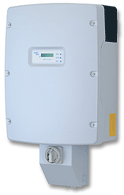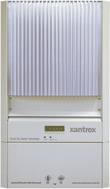With new technology and advancements in electronics, there are many great options to choose from when it comes to purchasing an inverter for your home or small business.
There are two types of inverters: Battery based and Grid-tied-only. Grid-tied-only based inverters are design primarily to do one thing, so they do it very well. They take the energy from an energy source, such as a wind turbine or set of solar panels and convert it into AC power that syncs up with to the utility company.
The battery based inverters are much more complicated, they do several things simultaneously, much like a three ring circus. The source based inverters are only grid connected. The battery based inverters can be either grid connected, off-grid or switchable between on and off-grid. There is a wide variety of options and quality in the battery based inverters but generally speaking Source based inverters are more common and are more efficient when converting the energy.
Grid-tied-only Inverters
Today’s high-tech inverters convert the solar panel’s DC current into solid AC power at efficiencies up to 96%. Many inverters have built in communications modules and sophisticated software to govern the inverter’s power curve for optimal performance.
Important features to look for when purchasing an inverter are the flexibility for system sizing, warranty, efficiency rating, indoor / outdoor mounting options and data communications options.
Because solar panels operate over a range of voltages (depending on the strength of the sun at any given time) the primary operation of the inverter is to govern this variant voltage and convert the DC current into usable AC electricity. To accomplish this efficiently, solar panels are connected in series, like batteries in a flashlight, to produce the proper string voltage. Some inverters are more flexible than others in what size strings are allowed. Some inverters allow string sizes between 5 and 10 panels. Others have minimum string sizes of 9 panels or more. This becomes a factor for example, when sizing a system; the property may not be able to fit another 9 panels but needs 6 more panels to achieve a zero annual bill. Choosing the wrong inverter may not get the customer the desired results.
For some states including California, it is important that the inverters (and panels) be approved by the states governing Energy Commission in order to qualify for local incentive money. In the case of California, it is the California Energy Commission (CEC) that approves each device.
It is also important to make sure that the warranty that comes with the inverter meets the minimum standard for the incentive program, it may be necessary to purchase an extended warranty to meet the incentive requirements.
Data communications become important if the inverter is mounted in a hard to reach area and remote operation is necessary or if the inverter needs to provide data for incentive programs that are performance based.
One common misconception is that just because a customer has a wind or solar system that when the power-grid goes down they will still have power. This is not true with these Grid-tied-only based inverters. If this is an important feature to you then you should look at the battery based inverters or some other type of back up power system.
Below are two of most common brands of Grid-tied-only inverters. For a more extensive list of available inverters and their features request more information using the contact form to the right or call us at (661) 209-7987.
SUNNY BOY BY SMA
The Sunny Boy inverters have made SMA the world market leader in the field of innovative device technology for renewable energy sources. SMA offers a wide range of different communication systems to accompany their inverters. The Sunny Boy 5000US, 6000US and 7000US are robust inverters equally suited for large residential or commercial applications. They are designed specifically to meet the new IEEE 1547 requirements. These inverters include an integrated AC and DC disconnect switch making installation more cost-effective and they come with a standard ten year warranty.
FRONIUS
Fronius offers inverters from 2kW to 5kW build with the same proven hardware and software as larger, more expensive commercial size inverters. Multiple inverters can be installed in a single location and with their advanced FRONIUS IGs’ load-sharing ability this inverters are highly efficient even under partial load conditions. Fronius inverter also offer the industries widest DC voltage range, allowing the greatest number of options with regard to different types of PV modules and system configurations (string sizes).Expansion slots in the inverter allow multi-inverter communications, and external data port and easy firmware upgrades.
Battery Based Inverters
When a battery based inverter is grid connected, an energy source such as wind power or solar power can send power to a charge controller. The charge controller then powers the current loads and sends power to the batteries. When the inverter senses that the batteries are full it will send any excess power to the utility company and cause the utility kilowatt hour meter to slow down, stop or even spin backwards.
When grid connected, these battery based inverters allow power to flow through them so that when a utility company outage occurs they can change states in less than a 20th of a second, drawing power from batteries. This transition occurs without power interruption, just like an uninterruptible power supply (UPS). Most battery based inverters automatically change states and others are programmable so the user can set priorities as to what the inverter does in various situations.
OUTBACK POWER SYSTEMS
Outback inverters are built to military specifications. OutBack makes grid connected inverters and off-grid inverters. All OutBack inverters can change states and become battery chargers. They are fully programmable and come standard with automatic controls to start and stop a backup generator. They are typically 91% efficient when converting battery power to AC power. The GVFX3648 is a 3.6kW inverter with a 48 volt battery bank and is accepted by many incentive programs. Outback power offers battery based, grid connected inverter packages up to 7.2kW and battery based off-grid packages up to 36 kW.
XANTREX
The SW Plus series inverters (2.5kW to 5.5kW) are designed for on-grid operation with automatic transfer for off-grid usage during a utility power failure. The SW Plus inverters offer customers the ability to install small to medium sized solar systems to reduce their utility cost and at the same time have a stable battery backup system for their home or office. The SW Plus can also automatically start and stop a generator for increased power capacity and can switch to battery back up mode during peak-rate periods to reduce utility cost. When utilizing the battery backup feature, these inverters can be strung together for a maximum power capacity of 14.2kW. Xantrex offers many other inverters, for various residential, commercial and mobile applications.
